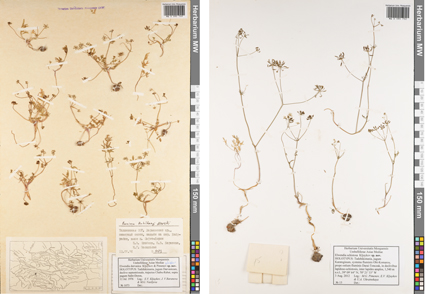Abstract
A study based on morphological and molecular (ITS/ETS nrDNA) data presents a taxonomic revision of the genus Elwendia in Tajikistan and neighbouring countries with a special attention to the E. kuhitangi – E. salsa complex. As a result, three new species of Elwendia from Tajikistan are described: E. darwasica, E. schistosa, and E. varsobica. Elwendia varsobica differs from all of these species by broad ovate-lanceolate sheaths of stem leaves and dorsally compressed mericarps. Elwendia darwasica and E. schistosa differ from E. kuhitangi and E. salsa by erect or slightly spreading styles of fruits. Improved morphological descriptions of E. kuhitangi and E. lindbergii as well as a new identification key for all Elwendia species known from Tajikistan and adjacent regions are provided. The distribution of E. lindbergii and E. capusii is expanded: E. lindbergii is reported for the first time from Tajikistan and E. capusii from Afghanistan.
References
<p>Bentham, G. (1848) Labiatae. <em>In:</em> Candolle, A. de & Candolle, A.P. de (Eds.) <em>Prodromus systematis naturalis regni vegetabilis</em>, vol. 12. Treuttel & Würtz, Paris, pp. 27–603.</p>
<p>Boissier, P.E. (1844) Plantae Aucherianae. <em>Annales des sciences naturelles. Botanique</em> Ser. 2, 3 (1): 120–151.</p>
<p>Degtjareva, G.V., Kljuykov, E.V., Samigullin, T.H., Valiejo-Roman, C.M. & Pimenov, M.G. (2009) Molecular appraisal of <em>Bunium</em> L. and some related arid and subarid geophilic Apiaceae-Apioideae taxa of the Ancient Mediterranean. <em>Botanical Journal of the Linnean Society</em> 160: 149–170. https://doi.org/10.1111/j.1095-8339.2009.00970.x</p>
<p>Degtjareva, G.V., Kljuykov, E.V., Samigullin, T.H., Valiejo-Roman, C.M. & Pimenov, M.G. (2013) ITS phylogeny of Middle Asian geophilic Umbelliferae-Apioideae genera with comments on their morphology and utility of psbA-trnH sequences. <em>Plant Systematics and Evolution</em> 299: 985–1010. https://doi.org/10.1007/s00606-013-0779-9</p>
<p>Drude, O. (1898) Umbelliferae. <em>In</em>: Engler, A. & Prantl, K. (Eds.) <em>Die natürlichen Pflanzenfamilien</em>, vol. 3 (8). Wilhelm Engelmann, Leipzig, pp. 63–250.</p>
<p>Franchet, A.R. (1883) Plantes du Turkestan. <em>Annales des sciences naturelles. Botanique</em> 6 (16): 280–336.</p>
<p>Hsiao, C., Chatterton, N.J., Asay, K.H. & Jensen, K.B. (1994) Phylogenetic relationships of 10 grass species: an assessment of phylogenetic utility of the internal transcribed spacer region in nuclear ribosomal DNA in monocots. <em>Genome</em> 37: 112–120. https://doi.org/10.1139/g94-014</p>
<p>Kamelin, R.V. (1977) New taxa of Central Asian Umbelliferae. <em>Novosti Sistematiki Vysshikh Rastenij</em> 14: 187–192.</p>
<p>Kljuykov, E.V. (1988) A survey of the genus <em>Bunium</em> L. Revision of the generic system. <em>Byulleten’ Moskovskogo Obshchestva Ispytatelei Prirody. Otdel biologicheskii</em> 93: 76–89. [In Russian]</p>
<p>Kljuykov, E.V. & Pimenov, M.G. (1983)<em> Bunium</em> L. <em>In</em>: Adylov, T.A. (Ed.) <em>Opredelitel’ rasteniy Sredney Asii: kriticheskiy konspekt flory</em>, vol. 7<em>.</em> Fan, Tashkent, pp. 228–235. [In Russian]</p>
<p>Kljuykov, E.V., Liu, M., Ostroumova, T.A., Pimenov, M.G., Tilney, P.M. & van Wyk, B.-E. (2004) Towards a standardised terminology for taxonomically important morphological characters in the Umbelliferae. <em>South African Journal of Botany</em> 70: 488–496. https://doi.org/10.1016/S0254-6299(15)30233-7</p>
<p>Kljuykov, E.V., Tojibaev, K.Sh. & Lyskov, D.F. (2018) The genus <em>Elwendia</em> Boiss. (Apiaceae) in the flora of Uzbekistan. <em>Turczaninovia</em> 21 (2): 210–220. https://doi.org/10.14258/turczaninowia.21.2.18</p>
<p>Korovin, E.P. (1924) Umbelliferae turkestanicae novae. <em>Botanicheskie materialy Gerbariya Glavnogo Botanicheskogo Sada RSFSR</em> 5 (6): 81–86.</p>
<p>Korovin, E.P. (1927) The genus <em>Bunium</em> L. and its Central Asian species. <em>Byulleten’ Sredne-Aziatskogo Gosudarstvennogo Universiteta</em> 15: 117–131. [In Russian]</p>
<p>Korovin, E.P. (1948) New species of Umbelliferae in flora of Uzbekistan. <em>Botanicheskie materialy Gerbaria Instituta botaniki i zoologii Academii nauk UzSSR</em> 12: 13–32. [In Russian and Latin]</p>
<p>Korovin, E.P. (1950) <em>Bunium</em> L. <em>In</em>: Schischkin, B.K. (Ed.) <em>Flora of USSR</em>, vol. 16. Academy of Sciences of the URSS, Moscow & Leningrad, pp. 396–411. [In Russian]</p>
<p>Korovin, E.P. (1959) Umbelliferae. <em>In</em>: Vvedensky, A.I. (Ed.) <em>Flora of Uzbekistan</em>, vol. 4. Academy of Science Uzbek SSR, Tashkent, pp. 257–470. [In Russian]</p>
<p>Korovin, E.P., Pimenov, M.G. & Kinzikayeva, G.K. (1984) Umbelliferae Moris. <em>In</em>: Ovchinnikov, P.N. (Ed.) <em>Flora of the Tajik SSR</em>, vol. 7. Academy of Sciences of USSR, Moscow & Leningrad, pp. 10–214. [In Russian]</p>
<p>Lazkov, G.A., Kljuykov, E.V. & Degtjareva, G.V. (2011) A new species of <em>Bunium </em>from Kyrgyzstan. <em>Botanicheskii Zhurnal </em>96: 967–970. [In Russian]</p>
<p>Linnaeus, C. (1753) <em>Species Plantarum</em>, ed. 1, vol. 1. L.Salvius, Holmia, 560 pp.</p>
<p>Logacheva, M.D., Valiejo-Roman, C.M., Degtjareva, G.V., Stratton, J.M., Downie, S.R., Samigullin, T.H. & Pimenov, M.G. (2010) A comparison of nrDNA ITS and ETS loci for phylogenetic inference in the Umbelliferae: an example from tribe Tordylieae. <em>Molecular Phylogenetics and Evolution</em> 57: 471–476. https://doi.org/10.1016/j.ympev.2010.06.001</p>
<p>Nevski, S.A. (1937) Materials for flora of Kuhitang and its foothills. <em>Transactions of Institute of Botany of Akademy of Science of SSSR. Series 1, flora and systematics of higher plants</em> 4: 199–346. [In Russian]</p>
<p>Pallas, P.S. (1779) Descriptiones plantarum Sibiriae peculiarium. <em>Acta Academiae Scientiarum Imperialis Petropolitanae. St. Petersburg</em> 2: 247–272.</p>
<p>Rechinger, K.H. (1987) <em>Bunium</em>. <em>In</em>: Hedge, I.C., Lamond, J.M., Rechinger, K.H., <em>et al.</em> (1987) Umbelliferae. <em>In</em>: Rechinger, K.H. (Ed.) <em>Flora iranica</em>, vol. 162. Akademische Druck- und Verlagsanstalt, Graz, Austria, pp. 236–257.</p>
<p>Rechinger, K.H. & Riedl, H. (1963) Umbelliferae. <em>In</em>: Koeie, M. & Rechinger, K.H. Symbolae afghanicae 5. <em>Biologiske Skrifter udgivet af det Kongelige Danske Videnskabernes Selskab</em> 13 (4): 27–135.</p>
<p>Regel, E.A. (1878) Plantae regionis Turkestanicas incolentes, secundum specimina sicca a Regelio et Schmalhausenio determinatae. <em>Trudy Imperatorskago S.-Peterburgskago botanicheskago sada</em> 5: 577–620.</p>
<p>Ronquist, F., Teslenko, M., van der Mark, P., Ayres, D., Darling, A., Höhna, S., Larget, B., Liu, L., Suchard, M.A. & Huelsenbeck, J.P. (2012) MrBayes 3.2: Efficient Bayesian phylogenetic inference and model choice across a large model space. <em>Systematic Biology</em> 61: 539–542. https://doi.org/10.1093/sysbio/sys029</p>
<p>Sprengel, C. (1813) Plantarum umbelliferarum denuo disponendarum prodromus. <em>Neue Schriften der naturforschenden Gesellschaft zu Halle</em> 2 (1): 3–42.</p>
<p>Swofford, D.L. (2003) PAUP*. <em>Phylogenetic Analysis Using Parsimony (*and Other Methods). </em>Version 4. Sinauer Associates, Sunderland, USA.</p>
<p>Vassiljeva, M.G., Kljujkov, E.V. & Pimenov, M.G. (1985) Karyotaxonomic analysis of the genus <em>Bunium</em> (Umbelliferae). <em>Plant Systematics and Evolution</em> 149: 71–88. https://doi.org/10.1007/BF00984155</p>
<p>White, T.J., Bruns, T., Lee, S. & Taylor, J. (1990) Amplification and direct sequencing of fungal ribosomal RNA genes for phylogenetics. <em>In</em>: Innis, M.A., Gelfand, D.H., Sninsky, J.J. & White, T.J. (Eds.) <em>PCR protocols: a guide to methods and applications</em>. San Diego, CA., pp. 315–322. https://doi.org/10.1016/B978-0-12-372180-8.50042-1</p>


